Drought conditions continue to deteriorate across all islands. Moderate drought (D1) conditions are now observed across Puerto Rico and Saint Thomas, with severe drought conditions noted in Saint Croix.
The most likely scenario during the next few months is for the persistence and expansion of drought conditions across all islands. The rainfall during the month of May will be crucial to determine if drought conditions will prevail during the summer months. Farmers are preparing now for the dry season ahead.
Key Points
- Puerto Rico Conditions: Limited rainfall activity has been observed across the local islands during the past few months. As a result, abnormally dry (D0) to moderate drought (D1) conditions continue to expand across nearly all of Puerto Rico, but especially along the southern coast, from Guayama west to Cabo Rojo. Some hints of severe drought (D2) are beginning to show near Aguadilla and parts of the municipalities of Moca, Isabela, and Mayaguez. The National Weather Station station at Coloso in the municipality of Mayaguez has reported only 4.45 inches of rain through April 4. This is the driest year-to-date total since 2014.
- U.S. Virgin Islands Conditions: Sporadic rain is occurring in the USVI, but wind and high temperatures are causing the loss of water from the soil and preventing the rains from saturating the soil. While the rainy season helped replenish some groundwater, drought is expanding and intensifying across the USVI, especially in St. Croix. Over the past 60 days, Rohlsen Airport has reported only 1.22 inches of rain, or about 40% of normal. This is the 4th driest such period in 63 years of data, or about 1 in 15 years of dryness, reflective of the severe drought (D2) being reported in the U.S. Drought Monitor.
- Puerto Rico Impacts: The fire danger weather in Puerto Rico continues to increase as dryness intensifies. There are reports of soil cracking, and dried and brown grass. A decreasing trend in water levels continued to be observed at reservoirs, rivers, and aquifers across Puerto Rico.
- U.S. Virgin Islands Impacts: Vegetation is beginning to show signs of distress due to the drier-than-normal conditions. Poultry farmers across the USVI are reporting a decrease in egg production due to heat.
- Looking Ahead: The most likely scenario during the next few months is for the persistence and expansion of drought conditions across the islands. The rainfall during the month of May will be crucial to determine if drought conditions will prevail entering the summer months.
- For weather information specific to your area, please monitor products issued by the National Weather Service in San Juan.
U.S. Drought Monitor map for Puerto Rico, as of April 4, 2023. The U.S. Drought Monitor is updated each Thursday to show the location and intensity of drought across the country.
The map uses 5 classifications: Abnormally Dry (D0), showing areas that may be going into or are coming out of drought, and four levels of drought (D1–D4).
U.S. Drought Monitor map for the U.S. Virgin Islands, as of April 4, 2023. The U.S. Drought Monitor is updated each Thursday to show the location and intensity of drought across the country.
The map uses 5 classifications: Abnormally Dry (D0), showing areas that may be going into or are coming out of drought, and four levels of drought (D1–D4).
U.S. Drought Monitor
D0 - Abnormally Dry
Abnormally Dry (D0) indicates a region that is going into or coming out of drought, according to the U.S. Drought Monitor. View typical impacts by state.
D1 – Moderate Drought
Moderate Drought (D1) is the first of four drought categories (D1–D4), according to the U.S. Drought Monitor. View typical impacts by state.
D2 – Severe Drought
Severe Drought (D2) is the second of four drought categories (D1–D4), according to the U.S. Drought Monitor. View typical impacts by state.
D3 – Extreme Drought
Extreme Drought (D3) is the third of four drought categories (D1–D4), according to the U.S. Drought Monitor. View typical impacts by state.
D4 – Exceptional Drought
Exceptional Drought (D4) is the most intense drought category, according to the U.S. Drought Monitor. View typical impacts by state.
U.S. Drought Monitor Categories
Abnormally Dry (D0)
Abnormally Dry (D0) indicates a region that is going into or coming out of drought. View typical impacts by state.
Moderate Drought (D1)
Moderate Drought (D1) is the first of four drought categories (D1–D4), according to the U.S. Drought Monitor. View typical impacts by state.
Severe Drought (D2)
Severe Drought (D2) is the second of four drought categories (D1–D4), according to the U.S. Drought Monitor. View typical impacts by state.
Extreme Drought (D3)
Extreme Drought (D3) is the third of four drought categories (D1–D4), according to the U.S. Drought Monitor. View typical impacts by state.
Exceptional Drought (D4)
Exceptional Drought (D4) is the most intense drought category, according to the U.S. Drought Monitor. View typical impacts by state.
U.S. Drought Monitor map for Puerto Rico, as of April 4, 2023. The U.S. Drought Monitor is updated each Thursday to show the location and intensity of drought across the country.
The map uses 5 classifications: Abnormally Dry (D0), showing areas that may be going into or are coming out of drought, and four levels of drought (D1–D4).
U.S. Drought Monitor map for the U.S. Virgin Islands, as of April 4, 2023. The U.S. Drought Monitor is updated each Thursday to show the location and intensity of drought across the country.
The map uses 5 classifications: Abnormally Dry (D0), showing areas that may be going into or are coming out of drought, and four levels of drought (D1–D4).
The U.S. Drought Monitor is updated weekly on Thursday morning, with data valid through that Tuesday at 7 am Eastern.
The U.S. Drought Monitor is updated weekly on Thursday morning, with data valid through that Tuesday at 7 am Eastern.
Current Conditions
Drought Conditions
- Puerto Rico: Nearly 75% of Puerto Rico is currently considered dry or in drought according to the U.S. Drought Monitor, with 45% categorized as Moderate Drought (D1) and 30% categorized as Abnormally Dry (D0), which is often a precursor to drought. The Moderate Drought (D1) conditions are now focused across the northwestern quadrant of the island as well as the southern slopes. This is expected to increase and worsen through April.
- U.S. Virgin Islands: Moderate Drought (D1) conditions are observed across Saint Thomas while Severe Drought (D2) conditions persist across Saint Croix. St. John is considered to be Abnormally Dry (D0).
Sector Impacts
General Conditions
- Puerto Rico: Dry and windy conditions in parts of Puerto Rico are leading to dry soil and vegetation, and an increased risk of wildfires.
- U.S. Virgin Islands: Ranchers note that conditions have been drier than normal, and vegetation is showing signs of distress. Farmers note that even with short and scattered rain, the wind and consistent heat are evaporating precipitation before the soil fully saturates. Poultry farmers across the USVI are reporting a decrease in egg production due to heat.
Agricultural Conditions
- Puerto Rico: In some regions, reduced rainfall is leading to low soil moisture, dry pastures, and affected crops. Browning vegetation and cracks in the soil show the effects of dry conditions. In Santa Isabel, dry conditions may be of concern to some farmers who rely on irrigation canals to provide water for their crops. One farmer reportedly constructed a structure to divert water from the irrigation canal to provide more water to their farm. Conditions appear to be increasingly dry in Toa Alta where one farmer shared that the soil is beginning to crack due to a reduction in rainfall in the past month. In San Germán, reported minimal rainfall and high winds have led to dry conditions.
- St. Thomas: Farmers are reporting hot, dry weather, which is adding to issues faced by farmers in the region, including that full ponds are beginning to evaporate due to heat. High winds have impacted soil moisture which has been reported at or above 20 MPH daily. Due to concerns over drought season, many are planning and preparing irrigation and water efficiency actions to better manage water as part of a longer-term mitigation and conservation plan, including the use of permaculture to aid them with soil moisture. Specialty and row crop farmers are working to manage water usage plans now and many are moving to drought-tolerant crops to keep production up while still conserving water. Livestock farmers are rotating to various areas to increase access to feed.
- St. John: Row and specialty crop farmers in St. John are reporting that they have had intermittent rain. The winds are high, which is impacting soil moisture, and farmers are preparing for a long, hot dry season. Most are currently focusing on microgreens, fruit trees, and quick crops to keep production levels up.
- St. Croix: Livestock farmers are working to plan for feed shortages later this summer due to a lack of grass during the hotter months. The Virgin Islands Department of Agriculture (VIDA) is currently buying and storing hay. Ranchers are looking at their drought mitigation strategies to plan for vegetation distress. Poultry farmers are now indicating that egg production has been reduced by up to 50% due to the heat. Poultry farmers also report they are concerned about conditions moving into the warmer months due to the demand for water required to produce. Furthermore, concerns about weather impacts and sales have plagued egg production farmers as they point to increased demand by consumers and their limited ability to address this demand due to the onset of drought and heat. Farmers who have poultry, including both broilers and/or egg production have smaller numbers because they must collect water in containers or use cistern water. VIDA on St Croix reported that in February they provided more than 1,000,040 gallons of water to farmers and in March supplied 1,105,000 gallons to farmers.
Rainfall Trends
Short-term rainfall deficits are observed across all islands, but especially over the past 60 days. The 60-day rainfall deficits are now ranging between 2 and 4 inches across most of Puerto Rico with locally higher amounts of 4–8 inches over the northwest quadrant of the island. As for the U.S. Virgin Islands, the year-to-date rainfall deficits are now running 2–3 inches below normal (Figure 1).
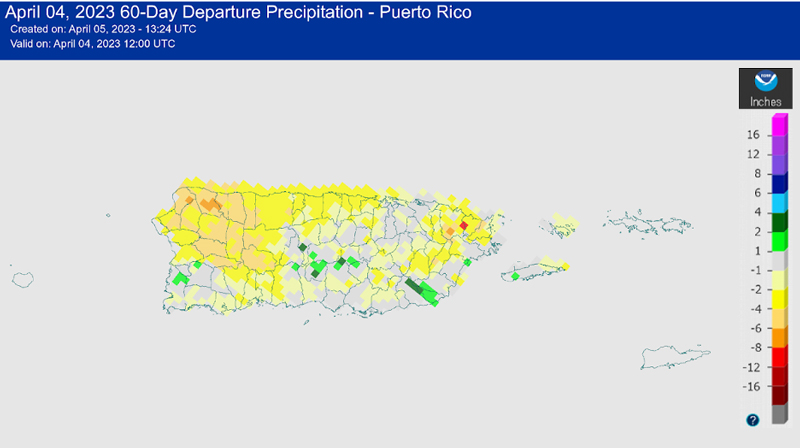
Soil Moisture Conditions in Puerto Rico
Based on soil moisture data from the Puerto Rico Agricultural Water Management (PRAGWATER), the driest soils and highest crop stress in Puerto Rico are currently observed in the northwest quadrant of the island, as well as in the southern slopes. In St. Thomas, the water level at the USGS Grade 3 School Well has dropped nearly 10 feet—from 2 feet below the surface in mid-November to nearly 12 feet below the surface (Figures 2, 3, and 4).
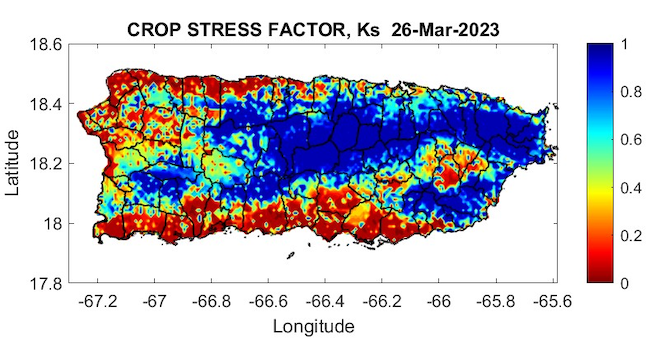
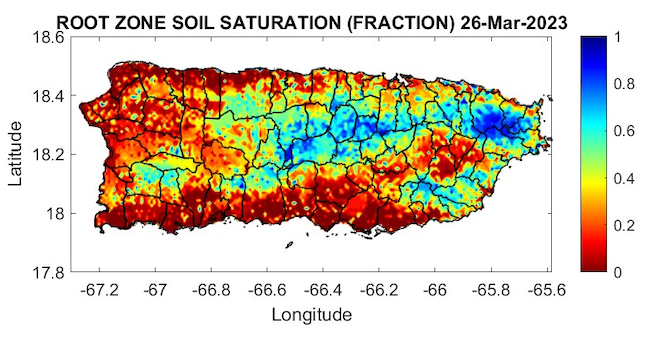
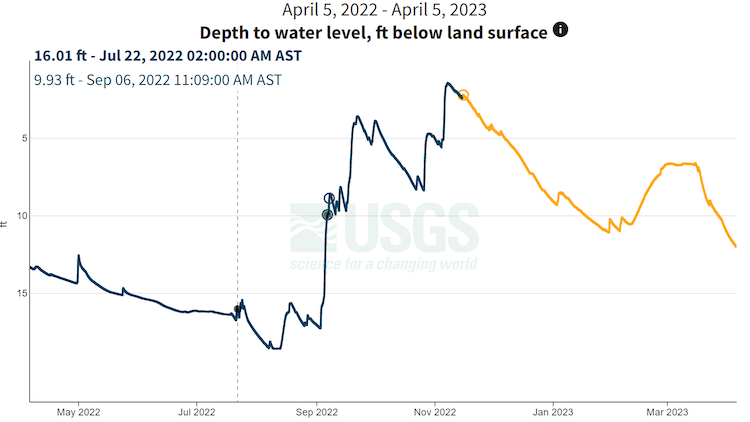
Streamflow and Reservoir Conditions in Puerto Rico
The real-time 28-day average streamflow from the U.S. Geological Survey (USGS) river gauge network (Figure 5) indicates most streamflows running below normal or well below normal across eastern and south Puerto Rico. Reservoir levels continued to recede with the Guajataca reservoir under close observation. Groundwater levels continued to recede across all islands as well.
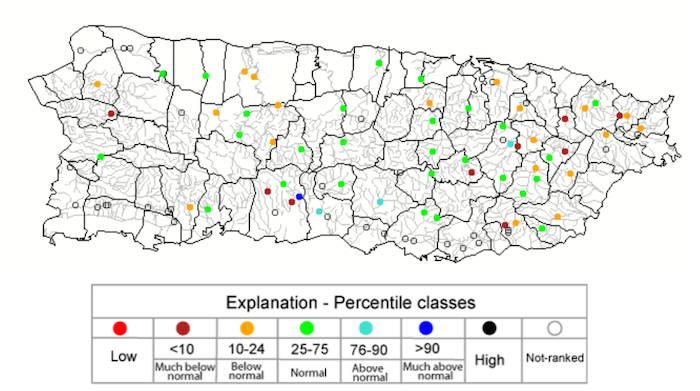
Outlooks
Rainfall Outlook
Based on the 3-month extended forecast for April, May, and June by the North American Multi-Model Ensemble (NMME) the entire Caribbean basin, including Puerto Rico and the U.S. Virgin Islands, are forecast to have drier than normal conditions (Figure 6). However, climatologically speaking, the month of May is wet. The rainfall during the month of May will be crucial to determine if drought conditions will prevail during the summer months.
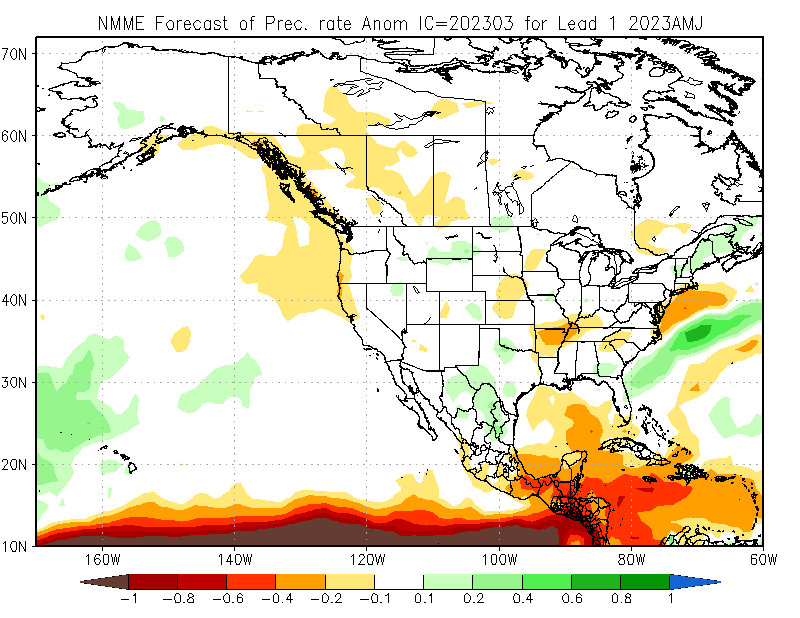
For More Information
- National Weather Service (NWS) Weather Forecast Office – San Juan: Climate and Drought Information
- NWS Drought Information Statements for Puerto Rico and the U.S. Caribbean
- Drought.gov:
- Caribbean Drought Bulletins. Caribbean Regional Climate Center, Caribbean Institute for Meteorology and Hydrology (CIMH), Barbados
- U.S. Department of Agriculture (USDA) Caribbean Climate Hub drought and disaster assistance resources for tropical forestry and agriculture
Prepared By
Héctor J. Jiménez
Office of Climatology, University of Puerto Rico
Odalys Martinez
National Weather Service Weather Forecast Office – San Juan
Meredith Muth
NOAA/National Integrated Drought Information System (NIDIS)
Victor Murphy
National Weather Service Southern Region
Christina Chanes, Gregory Guannel
University of Virgin Islands
Eva Holupchinski, Silmarie Crespo Vélez, and Nora Álvarez-Berríos
USDA Caribbean Climate Hub, USFS International Institute of Tropical Forestry
Brad Rippey
USDA Office of the Chief Economist
Puerto Rico Reporting Input: Thanks to the Agricultural Extension Service, College of Agricultural Sciences, University of Puerto Rico-Mayaguez. Special thanks to Eric Harmsen, Professor of Agricultural Engineering UPR-M; Isela Ortiz, Southwest Soil and Water Conservation District Inc. (DCSAS), Ian Pagán Roig, Agroecological Project el Josco Bravo; Agronomist Duamed Colón Carrión; and Professor. José L. Zamora.
USVI Reporting Input: Several individuals contributed to this report and we are acknowledging the following for their support including the farming community across the USVI, UVI faculty, staff and collaborators of the UVI School of Agriculture, UVI Physics Program, UVI Etelman Observatory, UVI Agricultural Experiment Station, VI Department of Agriculture, as well as the USDA Office Chief Economist, National Parks Service in St. Croix, VI Department of Planning and Natural Resources, USDA Farm Service Agency, Coral Bay Community Council and the many volunteer drought reporters and farmers from across the territory.
About This Report
This drought update is issued in partnership between the National Integrated Drought Information System (NIDIS), National Oceanic and Atmospheric Administration (NOAA) National Weather Service, the U.S. Department of Agriculture (USDA), and the University of the Virgin Islands. The purpose of the update is to communicate a potential area of concern for drought expansion and/or development within Puerto Rico and the U.S. Virgin Islands based on recent conditions and the upcoming three-month forecast.
NIDIS and its partners will issue these updates every two months. Subscribe for these U.S. Caribbean drought updates here.







